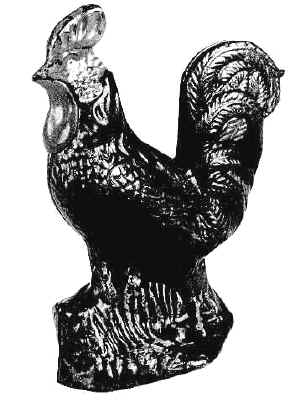Rooster (Crowing)
by F.H. Griffith - HOBBIES Magazine - May, 1982
 Birds as a subject matter form a small, but select group of the
mechanical banks. In this group there are such mechanicals as the Bird On Roof, Hen and
Chick, Eagle and Eaglets, Boy Robbing Bird’s Nest, Owl Type I and Type II, Owl (Turns
Head), Pelican Bank Type I, II, III and IV, Two Ducks Bank, and the Rooster Bank, our
present choice as No. 296 in the numerical classification.
Birds as a subject matter form a small, but select group of the
mechanical banks. In this group there are such mechanicals as the Bird On Roof, Hen and
Chick, Eagle and Eaglets, Boy Robbing Bird’s Nest, Owl Type I and Type II, Owl (Turns
Head), Pelican Bank Type I, II, III and IV, Two Ducks Bank, and the Rooster Bank, our
present choice as No. 296 in the numerical classification.
We should at this point mention that two other mechanicals fit into the bird category as well as, in each case, another category. These banks are the Monkey and Parrot and the Tabby Bank. The parrot on the Monkey and Parrot, of course, and the Tabby Bank with the chick coming out of the egg. The Uncle Remus Bank has overtones of this group since he is stealing chickens from a chicken house and a chicken is the operating lever. The Merry-Go-Round, along with the animals, has a swan and an ostrich. The last two banks, Uncle Remus and Merry-Go-Round, however, do not, strictly speaking, have birds as their subject matter.
A point of interest that bears mention. Fowl was originally a word for birds in general. Now fowl refers very commonly and specifically to a cock or hen; a barnyard or domestic fowl. So the Rooster Bank, while very definitely a bird, is also a fowl. This would apply to the Hen and Chick as well.
There are no known patent papers covering the Rooster Bank, nor are there any indications on the bank itself that would lead to such supposition. As a matter of fact, there are no markings on the bank whatsoever. It is the writer’s opinion that the bank was most likely made by Kyser and Rex of Philadelphia, Pennsylvania, circa mid-1880s-1890s. There is a possibility that it could have been manufactured by the Mechanical Novelty Works of New Britain, Connecticut.
The bank pictured is in excellent all original condition with paint near mint. The movable parts of the rooster’s head are red with white markings. The body of the rooster is a very dark japanned or bronzed type of finish with highlights of dark gold on the body and tail feathers as well. Silver is also lightly and sparingly apparent for highlighting. The base is an all over green with red and yellow designations thereon. Actually the way the bank is painted and the excellent detailed casting are the two main clues that lead the writer to believe that Kyser and Rex made the bank. In any case, it is a very attractive piece.
To operate the bank, a coin is placed in the forward section of the coin slot in the tail. A lever also in the tail slot is then pressed down causing the head parts to move in the realistic fashion of crowing. As the operating lever is pressed down the coin is automatically deposited inside the rooster. Coins are removed from the bank by taking it apart, this by means of a single screw.
